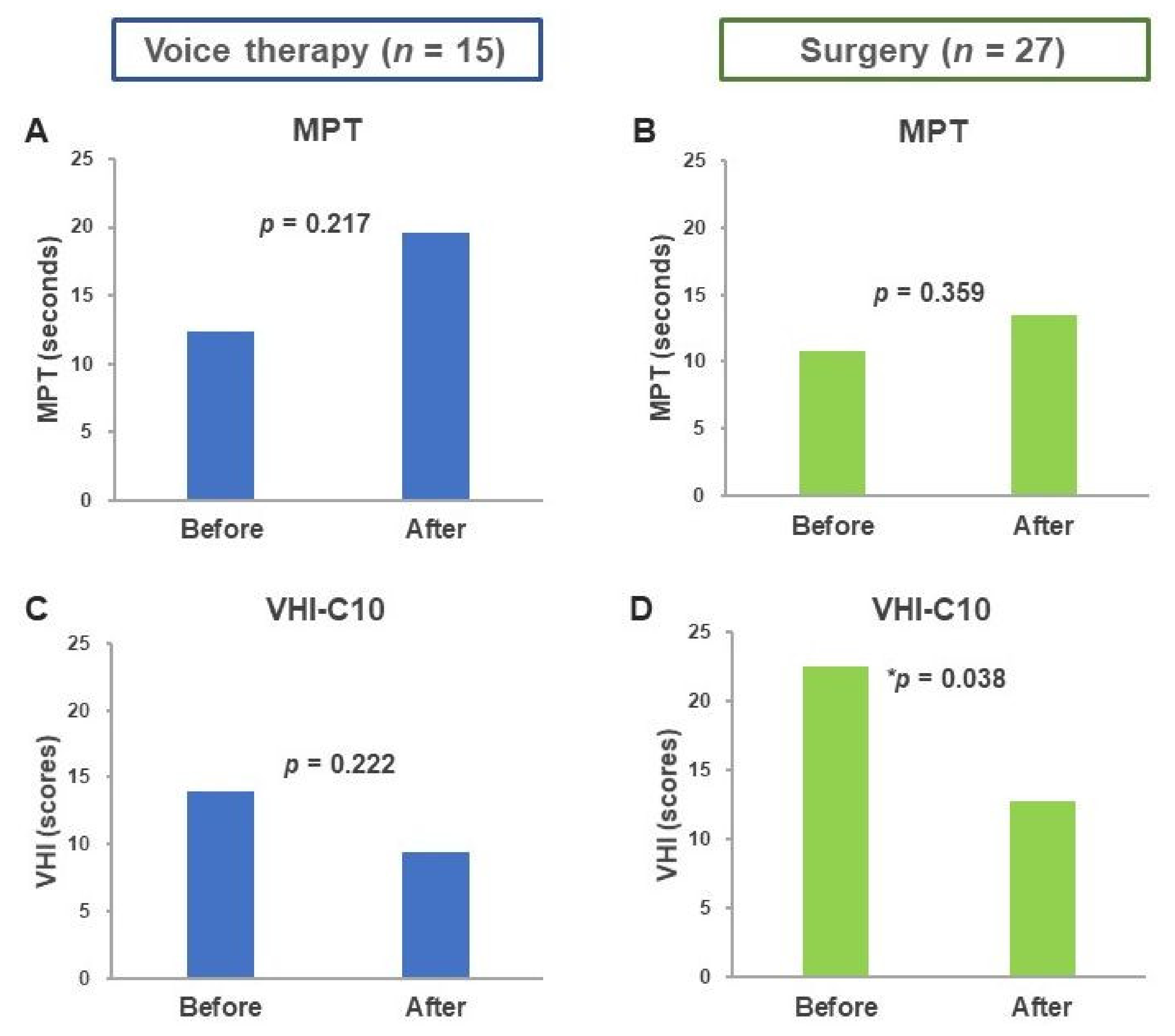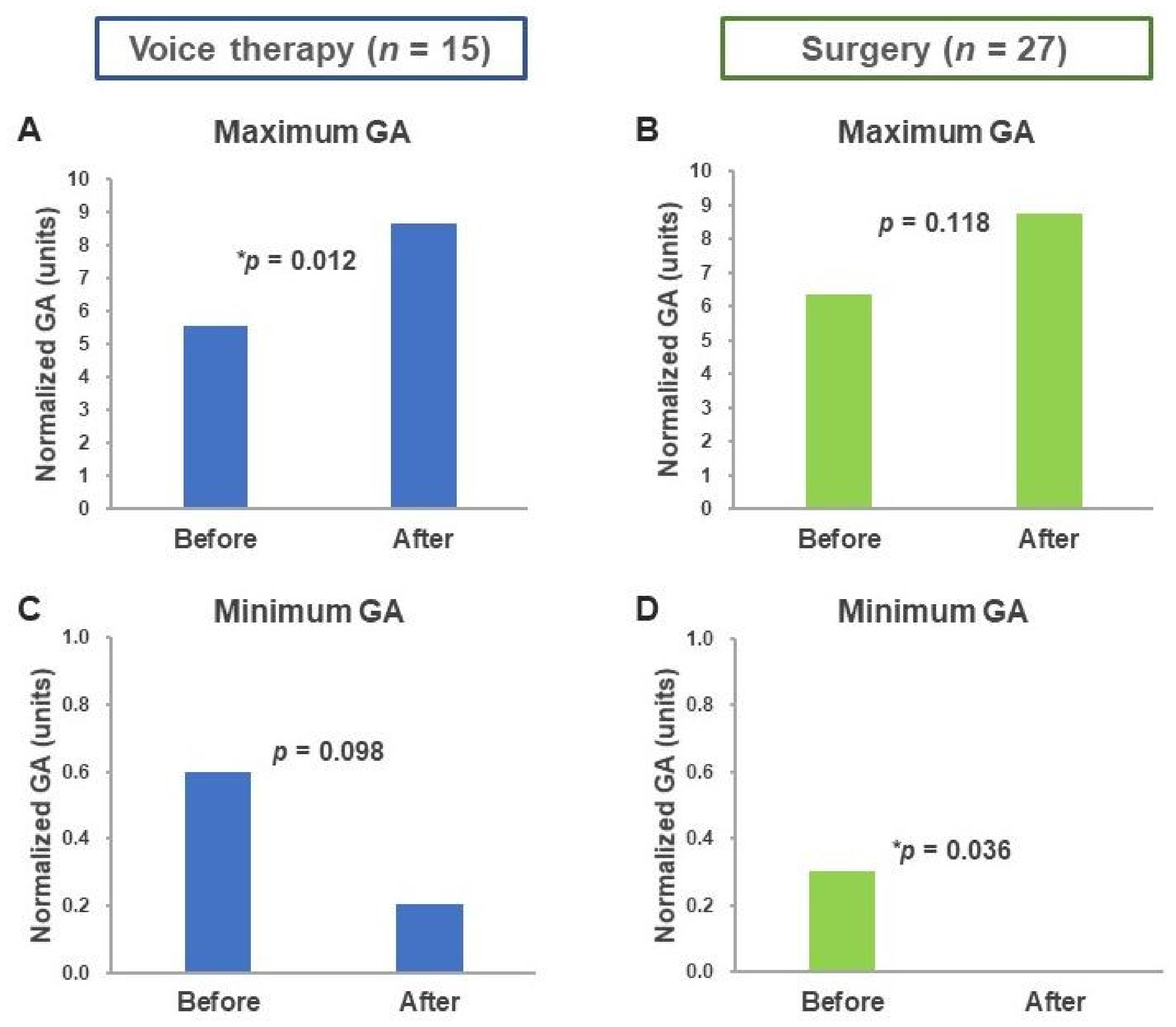Maximum and Minimum Phonatory Glottal Area before and after Treatment for Vocal Nodules
Abstract
1. Introduction
2. Methods
2.1. Patient Sources
2.2. Voice Analysis
2.3. Subjective Assessment
2.4. GA Measurement
2.5. Statistical Analysis
3. Results
3.1. Objective Voice Parameters
3.2. VHI-C10 Scores before and after Treatment
3.3. Maximum and Minimum Glottal Area
4. Discussion
5. Conclusions
Author Contributions
Funding
Conflicts of Interest
Abbreviations
References
- Wallis, L.; Jackson-Menaldi, C.; Holland, W.; Giraldo, A. Vocal fold nodule vs. vocal fold polyp: Answer from surgical pathologist and voice pathologist point of view. J. Voice 2004, 18, 125–129. [Google Scholar] [CrossRef] [PubMed]
- Leonard, R. Voice therapy and vocal nodules in adults. Curr. Opin. Otolaryngol. Head Neck Surg. 2009, 17, 453–457. [Google Scholar] [CrossRef] [PubMed]
- McHugh-Munier, C.; Scherer, K.R.; Lehmann, W.; Scherer, U. Coping strategies, personality, and voice quality in patients with vocal fold nodules and polyps. J. Voice 1997, 11, 452–461. [Google Scholar] [CrossRef]
- Song, B.H.; Merchant, M.; Schloegel, L. Voice Outcomes of Adults Diagnosed with Pediatric Vocal Fold Nodules and Impact of Speech Therapy. Otolaryngol. Head Neck Surg. 2017, 157, 824–829. [Google Scholar] [CrossRef]
- Tsai, M.-S.; Yang, Y.-H.; Liu, C.-Y.; Lin, M.-H.; Chang, G.-H.; Tsai, Y.-T.; Li, H.-Y.; Tsai, Y.-H.; Hsu, C.-M. Unilateral vocal fold paralysis and risk of pneumonia: A nationwide population-based cohort study. Otolaryngol. Head Neck Surg. 2018, 158, 896–903. [Google Scholar] [CrossRef]
- Patel, R.R.; Dubrovskiy, D.; Dollinger, M. Measurement of glottal cycle characteristics between children and adults: Physiological variations. J. Voice 2014, 28, 476–486. [Google Scholar] [CrossRef]
- Powell, M.E.; Deliyski, D.D.; Hillman, R.E.; Zeitels, S.M.; Burns, J.A.; Mehta, D.D. Comparison of Videostroboscopy to Stroboscopy Derived From High-Speed Videoendoscopy for Evaluating Patients With Vocal Fold Mass Lesions. Am. J. Speech Lang. Pathol. 2016, 25, 576–589. [Google Scholar] [CrossRef]
- Harden, J. Comparison of glottal area changes as measured from ultrahigh-speed photographs and photoelectric glottographs. J. Speech Hear Res. 1975, 18, 728–738. [Google Scholar] [CrossRef]
- Selamtzis, A.; Ternstrom, S.; Richter, B.; Burk, F.; Koberlein, M.; Echternach, M. A comparison of electroglottographic and glottal area waveforms for phonation type differentiation in male professional singers. J. Acoust. Soc. Am. 2018, 144, 3275. [Google Scholar] [CrossRef]
- Chen, G.; Kreiman, J.; Gerratt, B.R.; Neubauer, J.; Shue, Y.-L.; Alwan, A. Development of a glottal area index that integrates glottal gap size and open quotient. J. Acoust. Soc. Am. 2013, 133, 1656–1666. [Google Scholar] [CrossRef]
- Timcke, R.; von Leden, H.; Moore, P. Laryngeal vibrations: Measurements of the glottic wave: Part I. The normal vibratory cycle. AMA Arch. Otolaryngol. 1958, 68, 1–19. [Google Scholar] [CrossRef] [PubMed]
- Woo, P. Quantification of videostrobolaryngoscopic findings—Measurements of the normal glottal cycle. Laryngoscope 1996, 106, 1–27. [Google Scholar] [CrossRef] [PubMed]
- Gora, S.; Yavin, N.; Elad, D.; Wolf, M.; Primov-Fever, A. Computerized analysis of vocal folds vibration from laryngeal videostroboscopy. J. Voice 2016, 30, 478–484. [Google Scholar] [CrossRef] [PubMed]
- Schlegel, P.; Kniesburges, S.; Dürr, S.; Schützenberger, A.; Döllinger, M. Machine learning based identification of relevant parameters for functional voice disorders derived from endoscopic high-speed recordings. Sci. Rep. 2020, 10, 1–14. [Google Scholar] [CrossRef]
- Echternach, M.; Raschka, J.; Kuranova, L.; Köberlein, M.; Richter, B.; Döllinger, M.; Kainz, M.-A. Immediate effects of water resistance therapy on patients with vocal fold mass lesions. Eur. Arch. Oto-Rhino-Laryngol. 2020, 277, 1995–2003. [Google Scholar] [CrossRef]
- Powell, M.E.; Deliyski, D.D.; Zeitels, S.M.; Burns, J.A.; Hillman, R.E.; Gerlach, T.T.; Mehta, D.D. Efficacy of videostroboscopy and high-speed videoendoscopy to obtain functional outcomes from perioperative ratings in patients with vocal fold mass lesions. J. Voice 2019. In Press. [Google Scholar] [CrossRef]
- Ghasemzadeh, H.; Deliyski, D.D.; Ford, D.S.; Kobler, J.B.; Hillman, R.E.; Mehta, D.D. Method for vertical calibration of laser-projection transnasal fiberoptic high-speed videoendoscopy. J. Voice 2019. [Google Scholar] [CrossRef]
- Niebudek-Bogusz, E.; Kopczynski, B.; Strumillo, P.; Morawska, J.; Wiktorowicz, J.; Sliwinska-Kowalska, M. Quantitative assessment of videolaryngostroboscopic images in patients with glottic pathologies. Logop. Phoniatr. Vocology 2017, 42, 73–83. [Google Scholar] [CrossRef]
- Murphy, P.J. Spectral characterization of jitter, shimmer, and additive noise in synthetically generated voice signals. J. Acoust. Soc. Am. 2000, 107, 978–988. [Google Scholar] [CrossRef]
- Wertzner, H.F.; Schreiber, S.; Amaro, L. Analysis of fundamental frequency, jitter, shimmer and vocal intensity in children with phonological disorders. Braz. J. Otorhinolaryngol. 2005, 71, 582–588. [Google Scholar] [CrossRef]
- Jotz, G.P.; Cervantes, O.; Abrahão, M.; Settanni, F.A.P.; de Angelis, E.C. Noise-to-harmonics ratio as an acoustic measure of voice disorders in boys. J. Voice 2002, 16, 28–31. [Google Scholar] [CrossRef]
- Tsai, M.S.; Yang, M.Y.; Chang, G.H.; Tsai, Y.T.; Lin, M.H.; Hsu, C.M. Autologous thyroid cartilage graft implantation in medialization laryngoplasty: A modified approach for treating unilateral vocal fold paralysis. Sci. Rep. 2017, 7, 4790. [Google Scholar] [CrossRef] [PubMed]
- Lam, P.K.; Chan, K.M.; Ho, W.K.; Kwong, E.; Yiu, E.M.; Wei, W.I. Cross-cultural adaptation and validation of the Chinese Voice Handicap Index-10. Laryngoscope 2006, 116, 1192–1198. [Google Scholar] [CrossRef] [PubMed]
- Xu, W.; Han, D.; Li, H.; Hu, R.; Zhang, L. Application of the Mandarin Chinese version of the Voice Handicap Index. J. Voice 2010, 24, 702–707. [Google Scholar] [CrossRef] [PubMed]
- Omori, K.; Slavit, D.H.; Kacker, A.; Blaugrund, S.M. Quantitative videostroboscopic measurement of glottal gap and vocal function: An analysis of thyroplasty type I. Ann. Otol. Rhinol. Laryngol. 1996, 105, 280–285. [Google Scholar] [CrossRef]
- Noordzij, J.P.; Woo, P. Glottal area waveform analysis of benign vocal fold lesions before and after surgery. Ann. Otol. Rhinol. Laryngol. 2000, 109, 441–446. [Google Scholar] [CrossRef]
- Yamauchi, A.; Yokonishi, H.; Imagawa, H.; Sakakibara, K.; Nito, T.; Tayama, N.; Yamasoba, T. Age- and gender-related difference of vocal fold vibration and glottal configuration in normal speakers: Analysis with glottal area waveform. J. Voice 2014, 28, 525–531. [Google Scholar] [CrossRef]
- Teixeira, J.P.; Gonçalves, A. Algorithm for jitter and shimmer measurement in pathologic voices. Procedia Comput. Sci. 2016, 100, 271–279. [Google Scholar] [CrossRef]
- Remacle, M.; Friedrich, G.; Dikkers, F.G.; de Jong, F. Phonosurgery of the vocal folds: A classification proposal. Eur. Arch. Oto-Rhino-Laryngol. 2003, 260, 1–6. [Google Scholar] [CrossRef]
- Salturk, Z.; Ozdemir, E.; Sari, H.; Keten, S.; Kumral, T.L.; Berkiten, G.; Tutar, B.; Uyar, Y. Assessment of Resonant Voice Therapy in the Treatment of Vocal Fold Nodules. J. Voice 2018. [Google Scholar] [CrossRef]



| Characteristics | Total Patients (n = 42) | p Value | |
|---|---|---|---|
| Treatment | Voice therapy (n = 15) | Surgery (n = 27) | |
| Sex (Male/Female) | 5/10 | 12/15 | 0.482 |
| Mean age year (range) | 52.28 (25–75) | 48.0 (23–67) | 0.324 |
| MPT (sec) | 12.37 ± 5.47 | 10.77 ± 4.85 | 0.666 |
| Jitter | 2.38 ± 2.16 | 3.10 ± 2.85 | 0.418 |
| Shimmer | 0.55 ± 0.41 | 0.58 ± 0.3 | 0.785 |
| NHR | 0.20 ± 0.14 | 0.18 ±0.09 | 0.624 |
| VHI-C10 | 14.00 ± 8.44 | 22.53 ± 7.17 | 0.01 * |
© 2020 by the authors. Licensee MDPI, Basel, Switzerland. This article is an open access article distributed under the terms and conditions of the Creative Commons Attribution (CC BY) license (http://creativecommons.org/licenses/by/4.0/).
Share and Cite
Hsu, C.-M.; Yang, M.-Y.; Fang, T.-J.; Wu, C.-Y.; Tsai, Y.-T.; Chang, G.-H.; Tsai, M.-S. Maximum and Minimum Phonatory Glottal Area before and after Treatment for Vocal Nodules. Healthcare 2020, 8, 326. https://doi.org/10.3390/healthcare8030326
Hsu C-M, Yang M-Y, Fang T-J, Wu C-Y, Tsai Y-T, Chang G-H, Tsai M-S. Maximum and Minimum Phonatory Glottal Area before and after Treatment for Vocal Nodules. Healthcare. 2020; 8(3):326. https://doi.org/10.3390/healthcare8030326
Chicago/Turabian StyleHsu, Cheng-Ming, Ming-Yu Yang, Tuan-Jen Fang, Ching-Yuan Wu, Yao-Te Tsai, Geng-He Chang, and Ming-Shao Tsai. 2020. "Maximum and Minimum Phonatory Glottal Area before and after Treatment for Vocal Nodules" Healthcare 8, no. 3: 326. https://doi.org/10.3390/healthcare8030326
APA StyleHsu, C.-M., Yang, M.-Y., Fang, T.-J., Wu, C.-Y., Tsai, Y.-T., Chang, G.-H., & Tsai, M.-S. (2020). Maximum and Minimum Phonatory Glottal Area before and after Treatment for Vocal Nodules. Healthcare, 8(3), 326. https://doi.org/10.3390/healthcare8030326









